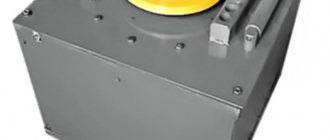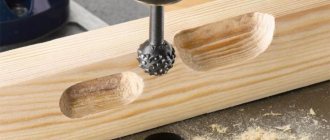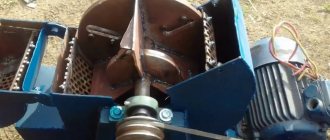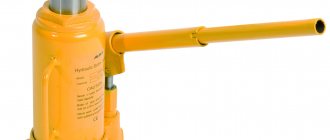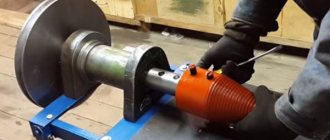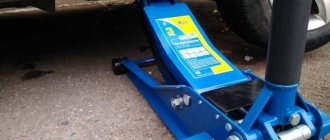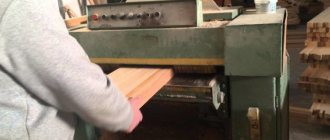Home craftsmen who make and repair various technical devices with their own hands often have to deal with pressing equipment. You can buy it on the modern market without any problems, but you can go the other way and make a functional and effective press with your own hands from a jack. By choosing this option for equipping your workshop with pressing equipment, you can manufacture a device at minimal cost that will fully meet the requirements for it, both in terms of technical and operational characteristics, and in size.
The press can be used for various purposes: for pressing bearings or bending metal. The design will be similar in any case, the only difference is the size and working attachments
Using a manual press made from a jack, which can fit in every workshop, you can successfully perform many technological operations at home, such as installing and dismantling bearings, pressing in and out of various bushings and shafts, and carrying out bending and simple stamping operations.
Design and functions of a hydraulic press
A hydraulic press is equipment that is specifically designed for processing parts and workpieces by applying high pressure to them. Such a press works due to the pressure of the liquid acting on the elements of its design.
The design of most hydraulic presses provides for a vertical arrangement of the working cylinder, but there are also models in which it is located horizontally. Various press models can create working forces ranging from several tens to several thousand tons.
Factory-produced hydraulic press option
The operating principle of a hydraulic press is based on Pascal's law, known to us from a school physics course. The design of the press consists of two working chambers of different sizes or, as they are also called, cylinders. The operating principle of a hydraulic press, to describe it in a few words, is as follows.
In the smaller of its cylinders, a high pressure of the working fluid is created, which is supplied through a connecting channel into a chamber of a larger diameter and acts on a piston connected to the working tool. The latter exerts pressure on the workpiece, which is located on a rigid support to prevent it from moving under its action. All hydraulic presses use special oils as the working fluid.
Operating principle of a hydraulic press
Hydraulic presses are most widely used when performing operations on metal parts such as stamping, forging, straightening, bending, extruding pipes and other profiles. In addition, with the help of such presses, briquetting, packaging and pressing of various materials is performed (as a rule, a mini-press is used for these purposes).
The design of the hydraulic press allows it to be actively used both in enterprises producing rubber, plastic and wood products, and in other areas. The variety of functions and applications of this equipment determine the existence of its various modifications. For example, on sale you can find a hydraulic table press, a mini press, a hydraulic floor press, a manual hydraulic press, presses with and without a pressure gauge.
Home use options
The use of a hydraulic press in a garage or home workshop is quite common. This type of press, which is small in size, can be used both for car repairs and for other types of work.
In particular, with the help of such compact equipment it is possible to press out bearings or silent blocks, as well as press new parts in their place. In addition to automotive repairs, a hydraulic press can be used for bending metal parts, creating the required pressure when gluing surfaces, briquetting waste, and squeezing out oil and liquid. Factory equipment for this purpose (even a manual hydraulic press) costs a lot of money, and not everyone can purchase it. Meanwhile, you can make such a press with your own hands, spending only money on purchasing the necessary materials.
Using a press as a juicer
What is noteworthy is that the design of a hydraulic press manufactured at home can immediately be adapted to solve a specific problem with a specific part or workpiece. A self-made press will not take up much space; to place it, it will be enough to allocate some space in a workshop or garage. Detailed instructions on how to make a hydraulic press are given below. There is also a video on this topic at the end of the article.
Application area
The main purpose of using a waste paper press is to recycle a variety of light waste:
- All kinds of paper (waste from enterprises, shops, markets, cafes and restaurants, shopping centers, etc.).
- Expired archival documentation.
- Cardboard boxes, packaging.
Using a waste paper press
When waste paper is compressed, its volume can be reduced by approximately 20 times, so this equipment will easily help you get rid of excess paper waste, which in its “raw” form takes up huge areas in premises and workshops.
Home press design
Self-made hydraulic presses should not have too outstanding technical characteristics; it is enough that they develop a force of 10–20 tons. This parameter of a homemade hydraulic press depends on what actions you are going to perform with its help.
One of the most common and simplest options for a homemade press
There are a number of other parameters that correspond to not only industrial, but also home-made household hydraulic presses:
- dimensions;
- weight of equipment;
- piston stroke;
- the presence of a pressure gauge in the design of the press;
- characteristics of the bed used.
In homemade presses, the pressure in the working cylinder is usually created using a manual hydraulic pump, which can be either built into the design of such a device or located separately from it. This design feature depends only on what equipment you choose to manufacture such a device. It is very easy to make a hydraulic press with your own hands if you take a bottle-type jack as the basis for its design. This jack, which is convenient, already has a built-in hand pump in its design.
A bottle-type hydraulic jack is great for use in a DIY hydraulic press.
Before you decide to purchase the right jack for your home hydraulic project, it is important to decide what tasks you will be using it to solve. Both the design of a manual hydraulic press and the force it will develop depend on this. The next step is to develop a drawing of the hydraulic press that you are going to make yourself. You can, of course, find such a drawing on the Internet and even watch photos and videos of the process of making a press from a hydraulic jack with your own hands. But in this case, you will be faced with the need to adjust your existing devices to someone else’s homemade press.
Manual hydraulic pump
Developing a drawing of your future homemade press begins with deciding how it will work. There are only two options here.
- The jack will be located at the bottom of the press - on its bed - and will press upward.
- The jack is fixed in the upper part of the press structure and, accordingly, presses down.
However, when choosing a scheme for the operation of a home-made press, one should take into account the fact that for the main part of the jacks produced by modern industry, the only correct location is with the pressing rod up, and placing them differently is simply not allowed. That is why most often the first scheme of a hydraulic press is taken as a basis. The second option is used only in cases where you need to make your own hydraulic equipment for pressing out bearings or bushings from individual components and mechanisms.
Press option with lower jack position
What to consider when developing a drawing of a homemade press
The supporting element of any press, including a homemade one, is the frame, the development of a drawing of which should be approached with the utmost responsibility. Structurally, the bed is a frame, inside of which there is a jack with a working tool that exerts pressure on the part or workpiece.
The type of bed may vary significantly depending on the purpose of the press
The frame of a self-made hydraulic press must have high strength, since it will experience loads in two directions at once. A jack that creates a certain force will simultaneously press on the upper and lower parts of the frame, trying to tear it apart. That is why, when calculating the frame and choosing materials for its manufacture, its strength is ensured with a margin.
The lower part of the frame - its base - is designed taking into account the fact that it must ensure high stability of the entire structure. When calculating the width of the internal opening of the frame of a homemade press, they take into account both the dimensions of the parts and workpieces that will be processed on it, as well as the total dimensions of all the components of the future press.
Another bed option with a simple base design to ensure stability
When calculating the height of the internal opening of the frame, the following parameters are summed up: the height of the jack, the desired amount of free play of its rod, the thickness of the working element and the part that needs to be processed. If a homemade press is made according to the first scheme, then its design is as follows: the jack is installed on the lower base, and the part is installed in the upper part of the frame; the force from the jack to the part is transmitted through its rod and a movable working platform moving along guides in the side elements of the frame.
In order to ensure that the rod returns to its original state, two springs are used, the lower part of which is attached to the base, and the upper part is attached to the movable working platform. If you decide to make a press from a jack with your own hands, then it is very important to correctly calculate the stiffness of the springs so that they effectively perform all the functions assigned to them.
When implementing the second scheme, a part is placed on the lower base, and the jack is installed on a movable platform, to which springs are also attached, connecting it to the upper crossbar of the frame. In both the first and second cases, a so-called socket is made at the point of contact of the rod with the movable platform or the upper crossbar of the frame, for which a piece of pipe of the appropriate diameter can be used.
The inability to adjust the height of the working area simplifies the design, but significantly limits the options for using the press
A self-made hydraulic press will be much more convenient to use if it includes the ability to adjust the free jack rod, which also affects the permissible height of the workpiece. To do this, you can do the following.
- In the upper part of the internal contour of the frame there is an additional plate, which can move along the guides due to a screw drive with a steering wheel. Thus, it is possible to change the clearance within a fairly wide range for the placement of parts inside the frame.
- You can make a removable stop, which is most often used as a mobile removable platform. The position of such a stop inside the frame can be fixed using bolted connections, for which holes are drilled in the frame at a certain pitch. In this case, the height spacing of such holes should not exceed the free play of the jack rod.
- From a solid piece of metal or a metal profile, you can make several replaceable inserts-gaskets of different thicknesses.
- You can also use several of the methods described above at the same time.
If you are making a drawing according to which you will make a press with your own hands, be sure to indicate not only the dimensions of the main elements of such a device and the workpiece, but also the dimensions of the channels and other rolled metal from which the frame will be made.
Tools and materials
If you are going to make a hydraulic press with your own hands, then you will need the following tools, consumables and equipment:
- welding equipment;
- electrodes;
- metal hacksaw or grinder (angle grinder).
In addition, you will need the following elements that will make up your future garage press: a hydraulic jack, two springs that will pull the movable platform to its original state. If you find an old bridge fungus in your garage left over from a renovation, it can be used as an element of a pulling device for homemade presses with a lower jack. In this case, the fungus is put on the jack rod, the upper part of the springs is attached directly to it, and the lower part is fixed to the frame.
The type and quantity of materials required to build a press greatly depends on the chosen design option.
In order to make a press from a jack, you will need the following rolled metal:
- channels (no less than 8 numbers), rectangular or square pipes (with dimensions no less than 40x40), corners with a shelf width of no less than 50 mm;
- a steel sheet with a thickness of at least 8 mm, which will be used as a reliable foundation for the entire structure;
- a piece of steel strip 10 mm thick - for the manufacture of guides and stiffeners, if necessary;
- a piece of pipe - for making sockets for the head of the jack rod.
Preparing for assembly
When pressing any paper products, you will need to construct a powerful unit. Those who make a paper press with their own hands need to consider the following parameters:
- device dimensions;
- total weight;
- presence of a pressure gauge;
- piston stroke;
- the size of the bed.
Before you start working on your future creation, you need to learn how to design a waste paper press with your own hands and what you may need to make it correctly. Usually, the master has everything he needs at hand and only needs to purchase a minimum set of items. To work you will need:
- ordinary jack;
- several springs;
- control elements;
- frame for the bed;
- metal pipe;
- wires through which current will flow.
Manufacturing process
When the drawing of your future hydraulic press is ready, and all the necessary materials, tools, equipment and components are available, we proceed directly to manufacturing. The first thing to do is to cut all the metal, guided by the dimensions indicated in the drawing.
One of the drawing options for making a press
Now you need to make the base of the press, for which prepared square pipes are welded together, and a steel plate is welded onto the rectangle formed from them. Then the side and top parts of the frame are welded together, carefully ensuring that the resulting U-shaped structure is smooth and has strictly right angles in the joints. Now the resulting structure should be welded to the base and we can assume that the frame for your hydraulic press is ready.
The next element that you will need to make for the press is a movable platform. To make it, you can use a channel, square or rectangular pipe. A piece of pipe is welded in the central part of the platform, which will serve as a socket for the head of the jack rod. To make guides for the working platform, you will need two steel strips, the length of which must correspond to the width of the press frame along its outer contour.
A variant of the press design with a movable lower platform, which is fixed with bolts
The strips are attached to the sides of the mobile platform using bolted connections, having previously brought it inside the frame. A removable stop is made using the same scheme, but holes are drilled in its guide strips opposite the frame posts to fix it at the desired height. The process of making a hydraulic press with your own hands is completed by installing tension springs and the jack itself. Such a hydraulic press is also convenient because you can always remove the jack from it (for example, if you need to use it to repair a car).
Appearance of a finished homemade press
One of the fairly economical variations of a hydraulic press, made with your own hands in your garage using simple devices, welding, a jack and channels.
Required drawings
As for the drawings and dimensions for making a press, there are a lot of options and possibilities. First you need to decide what size car you will use the jack with press for.
Everything here is extremely simple, the larger the machine, the correspondingly larger the press will be, and therefore the more sophisticated the drawings.
Let’s say right away that you won’t be able to make such drawings with your own hands, because they require precise engineering knowledge, but there is always a way out.
Check it out here too!
Crochet a crop top: patterns and ideasHow to make a homemade metal detector - the best diagrams, instructions. Review of proven options for creating a simple do-it-yourself metal detector
How to choose a washing machine: advice from professionals, the main subtleties of choosing a reliable and high-quality machine. Types, types, programs and functions
You can use many online resources where there are a large number of drawings of any size. But in short, the approximate numbers in the drawings will be as follows:
- A-1800
- B-1000
- F-500
- L-300
- Kg-120
